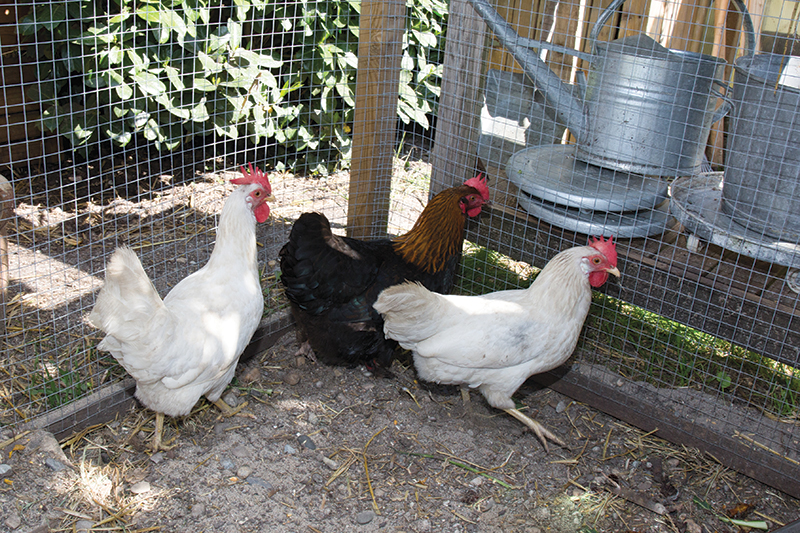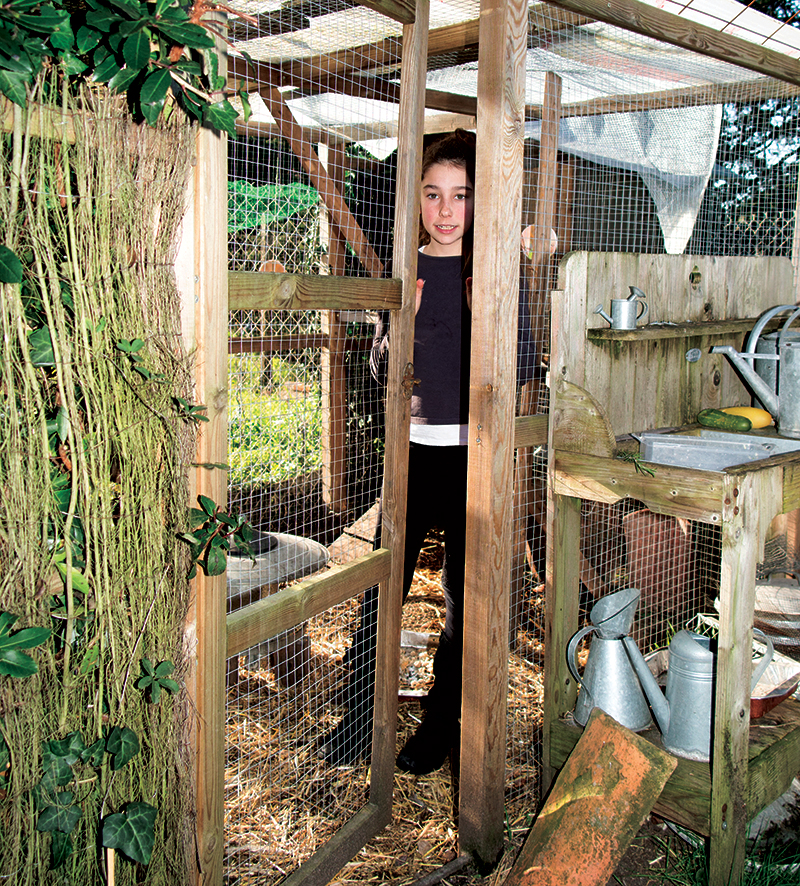
Chickens are messy creatures. Their normal scratching and dusting behaviors kick up debris, stir their own manure, and foul water and food supplies. A healthy flock requires regular attention to the cleanliness of their living quarters. Cleaning chores include those that need to be done daily, weekly and once or twice a year.
Fresh Water, Clean Food
Water and food are essentials for all life. Each day, flock owners can clean out and offer fresh food and water to their hens. Waterers often develop a greenish scrum on the insides and bottoms. Especially in warmer weather, this slime turns quickly from green to black. A scrubby sponge near the water spigot can help you stay ahead of green slime while easily scrubbing out the insides and blackish edges each time you add fresh water.
Free-ranging hens will also take advantage of low birdbaths and other yard water sources. Easily tipped and refilled, these water spots are favorites among small flocks.
Depending on the style of feeder, hens might kick debris into it or even perch on it and poop. Hens standing in the grain and kicking it around waste a lot of food. Through a process of trial and error with your particular feeder, you might find that providing less food and filling daily may reduce some food waste. Less food left in a feeder overnight will also decrease the amount of rodent traffic through your hen household. Bringing in the feeder at night or leaving it empty until morning is another way to reduce the attraction of unwanted wildlife.
Adding foodstuffs on a daily basis also allows you to make seasonal adjustments based on consumption. For instance, during the summer months, hens that are allowed to free-range during daylight hours may eat more insects and local greens than the grain you offer. During winter, though, when grasses, leaves and plantings are less abundant, your chickens might go through more grain. It’s essential to make layer feed available throughout the year because hens need its nutritional ingredients while producing eggs.
Weekly To Monthly
Small flock sizes vary, as do coop and run styles. These will be factors when considering regular housekeeping strategies. The type of bedding you choose will also teach you about frequency of changing or adding litter and the success of spot cleaning. Observation combined with trial and error can be your guide when it comes to a clean and sanitary environment for birds and egg laying.
Dropping boards under roosts are an excellent way to address the removal of manure in heavily used areas of the coop. The boards or manure piles can be removed on a daily, weekly or biweekly basis determined by the buildup your hens produce. Dropping boards allow bedding to remain cleaner longer, which saves time and materials. Droppings from boards can be collected and dispensed into a nearby compost pile for aging.
Dropping boards offer an added bonus: They are the first line of defense in detecting health issues with your hens. You might notice changes in manure, such as diarrhea or worms, which indicate treatable health challenges. Dropping boards might provide the only central location for observing health status in the form of manure. Daytime droppings will be distributed and churned into the bedding in runs or even more widely scattered during free-ranging hours.
This cleaning cycle lets bedding soak up moisture while taking out the densest manure buildup. Removing manure on dropping boards also results in less manure to be tracked into nest boxes and onto fresh eggs by the birds.

In the run, some flock keepers opt for the deep-litter or composting-litter method in managing cleanliness. Rather than removing bedding on a weekly, biweekly or monthly basis, fresh bedding is added on top of existing material. The fresh litter provides new absorbent material for manure while being stirred into the underlayer by the hens. The deep, naturally decomposing litter offers warmth for the hens during colder weather while also creating a balance that reduces the volume of material being put into the compost pile.
As with inside the coop, you will need to be observant about the conditions of the run. As hens scratch, low spots develop that catch rainwater and are churned into a muddy mess. At the same time, each favorite perching area can develop a heap of manure underneath; be alert to these less desirable conditions. Both can cause health hazards for your flock including attracting flies as well as the buildup of odors and disease-causing molds and bacteria.
In particular, wet spots inside and outside create the perfect breeding conditions for parasites and bacteria. Removing manure piles under perches and adding fresh, dry bedding in wet areas will help hens remain healthy. Use a pitchfork to stir the deep litter as a regular part of maintaining composting conditions. Raking and forking the composted litter will keep it from packing down and forming a crusty, impenetrable surface inside the run.
Strategies for housekeeping and frequency of cleaning are personal choices made by each chicken keeper. Some prefer more frequent cleaning influenced by factors beyond the coop. These factors might include proximity of neighbors and observed increases in wildlife. While neighbors might not be close enough to take in odors, chicken feed and manure — which is made up of undigested food — attracts local wildlife. You might find that daily or weekly cleaning reduces these attractions, adding to the security measures you keep in mind for your girls.
The Clean Sweep

Once or twice a year, you might choose to do a complete coop and run cleanout. For this you’ll need a rake, pitchfork, shovel, rubber gloves and even a face mask if conditions are dry and dusty.
While chickens are safely contained outside their living quarters, remove manure, bedding and leftover food scraps that have accumulated — think watermelon rinds and uneaten plant tops — as well as any other debris. Lift out roost bars, dropping boards and any other movable parts of the coop. Scrub these clean using an animal-safe cleaning solution of
1⁄2 cup vinegar and 1⁄4 cup baking soda mixed into 1⁄2 cup water. Let these coop parts dry in the sun as you dig out the layers of composted litter and add it to your compost pile.
Some chicken owners wash down the interior of their coops with vinegar and water while others choose not to add more moisture. Rather than washing down the interior, sweep walls removing dust, debris and cobwebs. You might want to wear a dust mask for this part of the process.
A complete cleanout lets you thoroughly inspect your coop structure. You might discover a leak in the roof, a spot where wildlife has tried to enter or evidence of poor ventilation, such as persistent wet areas. In mild weather, some hens roost on top of the coop, and you might find damage to roofing shingles. By now, your hens will have taught you how they utilize their facilities, so this is a good time to adjust for their needs.
A complete cleanout is a good time to level any areas in the run that have become worn by heavy traffic or deep scratching and dusting. During this process, consider what improvements might better support your flock. Do they need more run space? Would they benefit from a sand base in the run? Are you happy with the results of your bedding choices, or would you like to upgrade to a different kind of bedding?
Nest boxes that hang off the sides of a coop can become uneven with wear. Determine whether your nest boxes need more support or improved flooring to enable hens to comfortably lay eggs. A broody hen occupying a nesting box for a long time can put a strain on the box itself, so this is the time to evaluate box use and structural needs.

Composting Note
Fresh chicken manure is high in nitrogen, making it too hot to apply directly to active gardens. Fresh manure from dropping boards or collected from run roosts needs to age in your compost pile before it’s ready for use. However, the composted manure of the deep-litter method has already begun to break down. It can be further cooled in your compost pile or added to fall garden beds in anticipation of spring gardening.
After your deep clean is complete, reinstall roost bars, apply a thick layer of bedding, and put clean feeders and waterers back inside the run. You might notice that your hens are excitedly waiting to get back in their run and to scratch around in all of the new material you’ve provided them.
This story originally appeared in the September/October 2017 issue of Chickens magazine.




